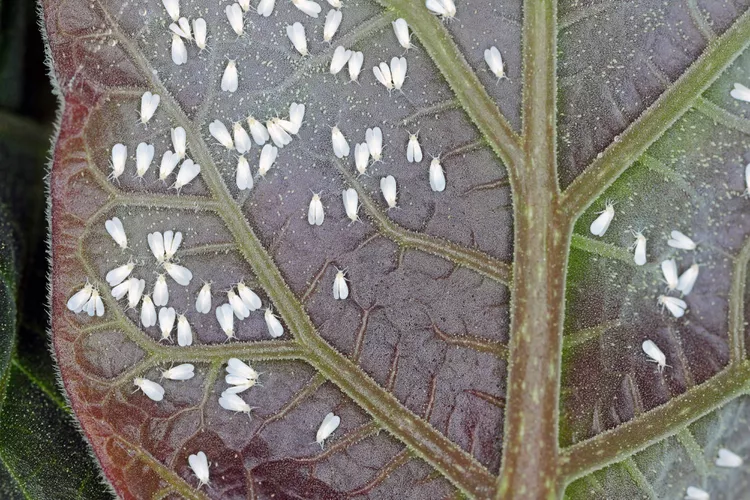If you see tiny white bugs on plants, clambering over leaves in a group or flying in a swarm when a plant is disturbed, you are probably dealing with whiteflies. Whiteflies are common plant pests that affect outdoor and indoor plants and plants grown in greenhouses. Although whiteflies are small, these pests spread rapidly, and large populations can weaken and even kill plants if left unchecked. If you suspect you’re dealing with whiteflies, you need to act fast. The organic pest control tips here will teach you how to get rid of whiteflies and prevent them from returning.
What Are Whiteflies?
Whiteflies are small, flying insects with yellow-to-white, triangular bodies that measure about 1/12-inch long. Despite their name, whiteflies aren’t flies; they are closely related to mealybugs and aphids. Like their plant pest cousins, whiteflies feed on plant sap and are most active during the day.
In warm areas, whiteflies survive outdoors all year round, but in USDA Zones 7 and colder, whiteflies are primarily encountered in greenhouses and houseplant collections. Many species of whiteflies target only specific types of plants, but silverleaf whiteflies and some other whitefly species are generalists that feed on a broad range of fruits, vegetables, and flowers. Whiteflies are most common on houseplants with smooth, soft leaves, but they also target many vegetables, including brassicas, sweet potatoes, and plants in the nightshade family.
Whitefly Life Cycle
One of the reasons whiteflies are so problematic is that these pests reproduce incredibly rapidly. In warm, humid environments, whiteflies can complete their entire lifecycle in just 16 days, and a single female whitefly lays about 400 eggs in her lifetime. Considering those statistics, it’s no wonder whitefly infestations can quickly overwhelm houseplants and greenhouses.
Female whiteflies typically lay their round, yellow eggs in a circular pattern on the underside of plant leaves. Those eggs hatch in about five days, and the nymphal whiteflies that emerge don’t travel far before they attach themselves to plant leaves and start feeding. After the larvae have fed enough, they pupate and turn into mature whiteflies with wings. Interrupting the whitefly lifecycle before mature adults lay more eggs is the best way to tackle whitefly infestations and keep them from spreading.
Signs of a Whitefly Infestation
Diagnosing a whitefly infestation can be tricky since whiteflies, aphids, and mealybugs all cause similar damage on plants. Like aphids and mealybugs, whiteflies weaken plants as they feed, making it harder for plants to photosynthesize. As infestations progress, plant leaves may yellow, wilt, and fall off, and the plant’s growth becomes stunted.
You might notice a sticky “honeydew” residue or sooty mold on affected plant leaves, which are signs that you’re dealing with whiteflies or other sap-sucking pests.
Because whitefly problems so closely resemble the symptoms of other plant pest infestations, it’s essential to inspect your plants carefully to determine if you’re dealing with whiteflies or another insect. Whiteflies often congregate on fresh growth and the undersides of plant leaves or around leaf veins, but they also fly up in swarms when disturbed. If you suspect your plants are infested, gently shake the leaves. If small, white insects fly out, chances are good you have a whitefly problem.
How to Get Rid of Whiteflies
Preventing whitefly infestations before they happen is always the best option. But if whiteflies have found your plants, you can eliminate these destructive pests without chemical pesticides.
Spray plants with a garden hose to dislodge adult and larval whiteflies. After that, treat the plants with an organic neem oil or insecticidal soap spray made with a few drops of Castile soap mixed into a quart of water. Apply sprays to the tops and undersides of plant leaves, as well as to plant stems and the top of the soil line. It’s best to apply sprays in the early morning or the evening and reapply them every 7 to 10 days until you don’t see any more signs of whiteflies.
While soap sprays are effective, you’ll get even better results using multiple treatment methods. This tactic is known as integrated pest management (IPM). For example, combine organic insecticidal sprays with sticky traps and vacuum up adult and larval whiteflies with a handheld insect vacuum. You may also want to release beneficial insects into your garden. Of course, don’t forget to monitor your plants regularly to ensure whiteflies don’t creep back into your garden.
Preventing Whiteflies
Healthy plants can resist pests more easily than weak ones, so if you want to keep whiteflies out of your garden or houseplants, make sure the plants receive the care they need. That means providing regular water, the right amount of sun, and a little fertilizer.
Outdoor Gardens
Aside from maintaining plant health, you can avoid whiteflies in outdoor gardens by experimenting with companion planting. Plants like nasturtiums and marigolds are known to repel many pests, while sunflowers and zinnias attract predatory insects and hummingbirds that feed on whiteflies.
Installing reflective mulch or a bit of aluminum foil around the base of vulnerable plants might confuse whiteflies and prevent their spread.
Interestingly, whiteflies are resistant to many synthetic pesticides and can be particularly problematic in gardens where pesticides are used. While pesticides may not harm whiteflies, they kill many beneficial insects that feed on whiteflies, including lacewings and ladybugs. Keeping your garden as organic as possible and growing plants like yarrow and dill to attract predatory insects will maintain your garden’s natural balance and allow predatory insects to manage whiteflies for you.
Houseplants
If you keep houseplants, avoid whiteflies by checking new plants carefully before you bring them indoors. You may also want to spray new arrivals with an organic insecticidal soap to ensure whiteflies and other pests don’t hitch a ride into your home.




















